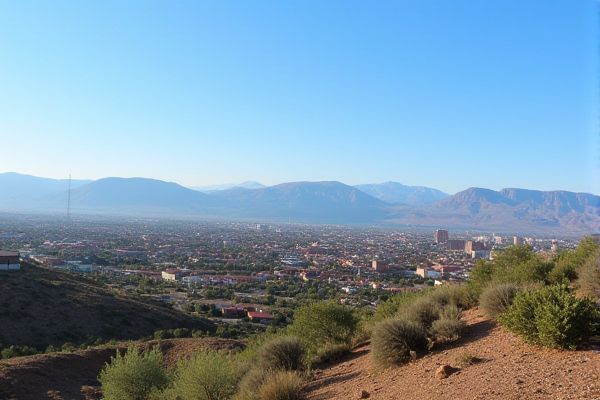
Weather and climate in Utah: Semi-arid to arid climate. Hot, dry summers. Cold, snowy winters. Four distinct seasons. Great Salt Lake effect. High elevation influences weather. Variable temperature ranges. Occasional thunderstorms. Winter inversion pollution. Low humidity levels.
Semi-arid to arid climate.
Utah's climate is diverse, with semi-arid to arid regions. The semi-arid areas receive 10-20 inches of precipitation annually, while arid regions receive less than 8 inches. The latter is characterized by high evapo-transpiration rates and localized convectional rainfall leading to flash floods. To explore more detailed information about Utah's unique climate, you can visit the Physical Geography Utah page.
Hot, dry summers.
Utah's summers are traditionally characterized by hot, dry conditions, but recent trends indicate a shift towards more humid summers due to climate change, with warmer global temperatures allowing air to hold more moisture and occasional severe weather events contributing to increased humidity. Despite this, Utah's summers remain hot, with frequent days above 90°F and occasional thunderstorms providing temporary relief from the dry heat. For more detailed insights on this climatic transition, visit the Kuer Website, which explores how these changes are reshaping weather patterns in the region.
Cold, snowy winters.
Utah experiences cold and snowy winters, with temperatures sometimes dropping as low as 5°F. The state is famous for its light, fluffy snow, particularly in the mountains, which is influenced by the lake effect of the Great Salt Lake. Interestingly, winters are warmer than expected due to the blocking effect of the Rocky Mountains. For more detailed information, you can refer to the Utah Weather and Snow Report, which provides further insights into these unique weather conditions.
Four distinct seasons.
Utah experiences four distinct seasons, offering a moderate climate with temperatures ranging from 39°F to 92°F. The state is characterized by cold, snowy winters, hot, dry summers, and relatively wet spring and fall transition periods. Notably, the weather can vary significantly by region, with mountain areas being about 20 degrees cooler than the valleys. For those planning a visit to this captivating region, information about the local climate can be explored further on the Utah Valley Weather page.
Great Salt Lake effect.
The Great Salt Lake Effect is a local climate and weather phenomenon where the lake, which rarely freezes due to its salinity, enhances precipitation by warming rapidly and interacting with cold, northwesterly winds, particularly after cold front passages. This interaction can produce significant snowstorms, known as "lake-effect snow," which are crucial for Utah's ski industry and water supply. For more detailed information, visit the Great Salt Lake Effect page on Wikipedia.
High elevation influences weather.
Utah's high elevation significantly influences its weather, as the mountains force moist air to rise, resulting in precipitation before reaching the state and leaving prevailing westerly air currents comparatively dry. The elevation effect, causing a decrease in mean annual temperature for every 1,000-foot increase, leads to notable variations in temperature according to latitude. This phenomenon is crucial in shaping the cooler climates found in the mountains and elevated valleys of the region. For a more detailed understanding of how elevation impacts climates in Utah, you can visit the Western Regional Climate Center.
Variable temperature ranges.
Utah experiences significant variable temperature ranges, with daytime and nighttime temperatures often differing by more than 30 degrees. The state's climate is characterized by a large diurnal temperature range, especially in desert regions like Arches National Park, where temperatures can fluctuate by as much as 40 degrees in a single day.
Occasional thunderstorms.
In Utah, occasional thunderstorms are common, particularly during the summer months, often associated with the summer monsoon from Mexico and Arizona. These monsoons bring intense but short-lived thunderstorm activity, including dry lightning that can cause wildfires. Such storms can also lead to flash floods, especially in areas recently burned by wildfires. For more detailed information, you can visit the Climate of Salt Lake City page on Wikipedia.
Winter inversion pollution.
Winter inversions in Utah occur when warmer air traps colder air in the valleys, leading to high levels of fine particulate pollution (PM2.5) that can cause respiratory and cardiovascular health issues. This phenomenon is particularly exacerbated by snow cover, topography, and vehicle emissions. For more detailed insights, explore the effects of these https://www.bestheatcoolutah.com/salt-lake-city-winter-inversions-affect/ winter inversions on air quality and health in Salt Lake City. Understanding these impacts can help in taking preventive measures to alleviate the adverse effects on public health during the colder months.
Low humidity levels.
Utah is characterized by low humidity levels, with the state being one of the driest in the country. The average relative humidity in Utah ranges from 74.3% in December to as low as 35.9% in July, making the heat feel more palatable due to the lack of moisture in the air. For more information on planning your trip and addressing weather-related concerns, you can visit the Utah Travel Guide for detailed insights and recommendations.
